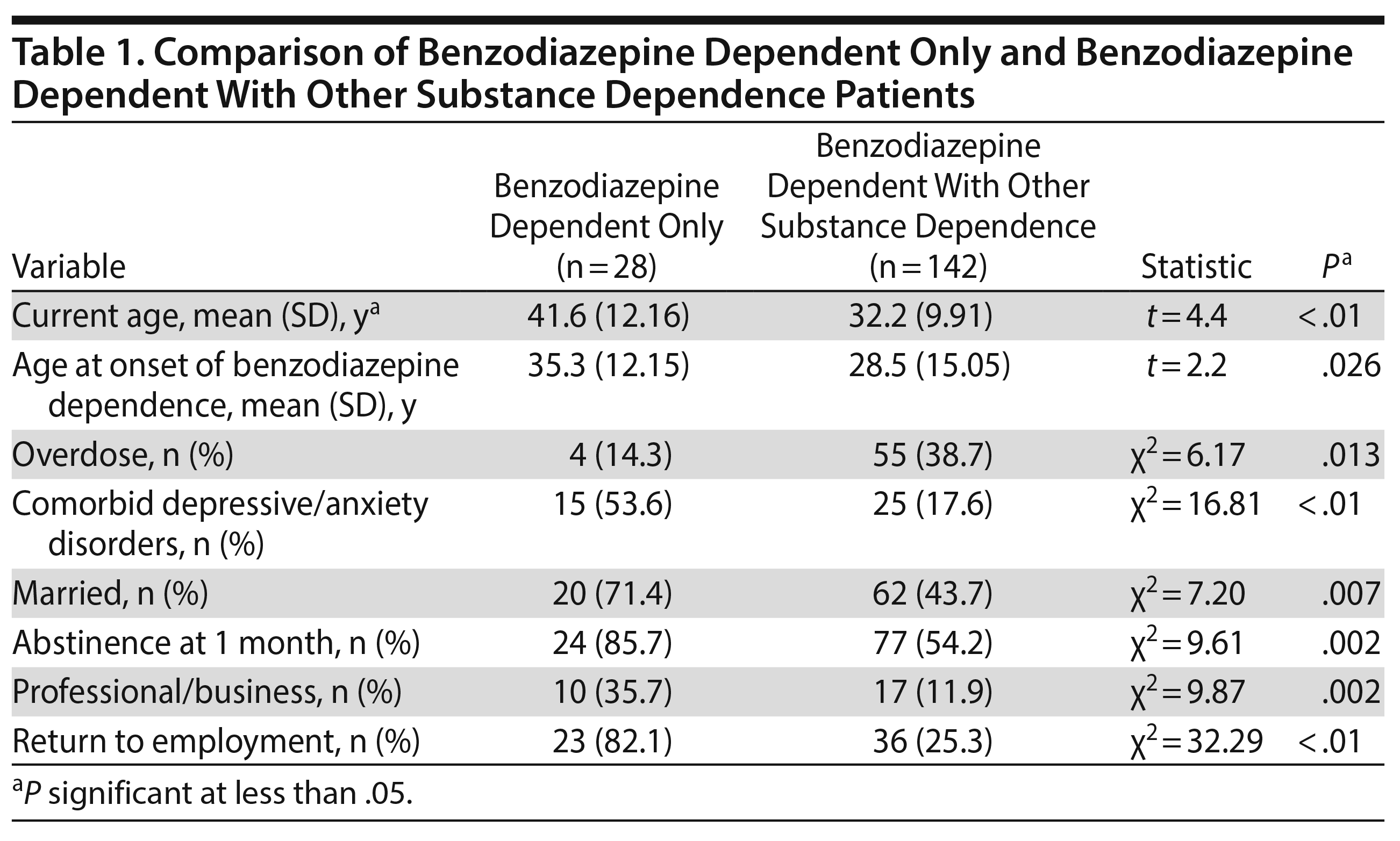Objective: To examine the clinical characteristics and course of benzodiazepine and "Z-drug" dependence in patients presenting to a tertiary deaddiction center in southern India.
Methods: Case files of 950 inpatients admitted between January 2007 and January 2014 who reported benzodiazepine or Z-drug use were reviewed. Patients (n = 170) with an ICD-10 diagnosis of mental and behavioral disorders due to the use of sedatives or hypnotics-dependence syndrome currently using substance (F13.24) were included in this study.
Results: Alprazolam (n = 86, 50.6%), nitrazepam (n = 40, 23.5%), and zolpidem (n = 19, 11.2%) were the most commonly reported drugs of abuse. Alcohol dependence was present in 37 subjects (21.8%) and opioid dependence in 41 subjects (24.1%). Comorbid psychiatric illness was diagnosed in 67 patients (39.0%). Only 28 patients (16.5%) had sedative dependence with no other substance use disorder.
Conclusion: High comorbidity occurs in this group of patients. Outcome varies significantly (P < .05) between sedative-dependent only and multiple-substance-dependent patients. High attrition should be addressed through follow-up and tracking mechanisms.

Benzodiazepine and "Z-Drug" Dependence:
Data From a Tertiary Care Center

ABSTRACT
Objective: To examine the clinical characteristics and course of benzodiazepine and "Z-drug" dependence in patients presenting to a tertiary deaddiction center in southern India.
Methods: Case files of 950 inpatients admitted between January 2007 and January 2014 who reported benzodiazepine or Z-drug use were reviewed. Patients (n = 170) with an ICD-10 diagnosis of mental and behavioral disorders due to the use of sedatives or hypnotics-dependence syndrome currently using substance (F13.24) were included in this study.
Results: Alprazolam (n = 86, 50.6%), nitrazepam (n = 40, 23.5%), and zolpidem (n = 19, 11.2%) were the most commonly reported drugs of abuse. Alcohol dependence was present in 37 subjects (21.8%) and opioid dependence in 41 subjects (24.1%). Comorbid psychiatric illness was diagnosed in 67 patients (39.0%). Only 28 patients (16.5%) had sedative dependence with no other substance use disorder.
Conclusion: High comorbidity occurs in this group of patients. Outcome varies significantly (P < .05) between sedative-dependent only and multiple-substance-dependent patients. High attrition should be addressed through follow-up and tracking mechanisms.
Prim Care Companion CNS Disord 2017;19(1):16br02025
https://doi.org/10.4088/PCC.16br02025
© Copyright 2017 Physicians Postgraduate Press, Inc.
aCentre for Addiction Medicine, Department of Psychiatry, National Institute of Mental Health and Neurosciences, Bangalore, India
*Corresponding author: Lekhansh Shukla, MD, PDF, Centre for Addiction Medicine, Department of Psychiatry, National Institute of Mental Health and Neurosciences, Hosur Rd, Bangalore, Karnataka 560029, India ([email protected]).
Benzodiazepine and "Z-drug" (zaleplon, zolpidem, and zopiclone) dependence are reported worldwide.1,2 Misuse of prescription drugs is an emerging problem in South Asian countries that requires further investigation.3 We examined the clinical characteristics and course of benzodiazepine and Z-drug dependence in patients presenting to a tertiary care deaddiction center in southern India.
METHODS
A chart review was conducted at the Centre for Addiction Medicine, which is attached to the National Institute of Mental Health and Neurosciences (NIMHANS), Bangalore, India. We reviewed 950 case records of inpatients admitted between January 2007 and January 2014 who reported benzodiazepine or Z-drug use. For the purpose of the current study, case files of patients (n = 174) with a diagnosis of mental and behavioral disorders due to the use of sedatives or hypnotics-dependence syndrome currently using substance (ICD-10 F13.24) were then reviewed by 3 of the investigators (L.S., S.B., and T.S.). Data from the case records were extracted using a structured form created by the authors. The typical dose of benzodiazepine use per day (per patient report) was calculated in diazepam milligram equivalents on the basis of published literature.2 The study was approved by the ethics committee of NIMHANS.
RESULTS
The final sample (n = 170) consisted of 158 (93%) males and 12 (7%) females with a mean (SD) age of 32.7 (10.8) years. Fifty percent of subjects (n = 86) were unemployed, although 75% (n = 128) had more than 12 years of education. While 75% of patients (n = 127) reported sedative use as the primary reason for seeking treatment, 83.5% (n = 142) were dependent on at least 1 substance in addition to sedatives (excluding nicotine). In the group of patients who had additional substance dependence, opioid (n = 41), alcohol (n = 37), cannabis (n = 3), and solvent (n = 1) dependence was diagnosed, and 60 patients were dependent on more than 2 classes of substances. Also, 39% of patients (n = 67) were diagnosed with comorbid psychiatric illness: major depressive disorder (n = 28), bipolar disorder (n = 16), generalized anxiety disorder (n = 10), schizophrenia (n = 7), social phobia (n = 4), and obsessive-compulsive disorder (n = 2). Only 28% of patients (n = 48) reported introduction to sedatives through prescription. The remaining patients (n = 122) were introduced to sedatives through over-the-counter sales (n = 60) or peers (n = 62).

- Benzodiazepine and Z-drug dependence is frequently comorbid with other substance use disorders and psychiatric disorders.
- Nitrazepam, alprazolam, and zolpidem account for the majority of sedative dependent cases.
- Patients who receive these agents will benefit from frequent evaluation for drug abuse or misuse.
Alprazolam (n = 86, 50.6%), nitrazepam (n = 40, 23.5%), and zolpidem (n = 19, 11.2%) were the commonly abused sedatives in the patient sample. Overdose severe enough to require medical attention was reported by 67 patients (39%). Reported overdose instances were due to a combination of sedatives with opioids (n = 40) and alcohol (n = 27). The mean (SD) daily intake of benzodiazepine is calculated as 149.4 (52.9) mg of diazepam equivalents. Nineteen patients taking zolpidem reported a mean (SD) daily intake of 120 (20) mg. Table 1 summarizes salient differences between patients taking only sedatives (n = 28) and patients taking sedatives with other substances (n = 142).
CONCLUSION
There are a number of important findings from this study. First, a small number of drugs (alprazolam, nitrazepam, and zolpidem) account for the majority of cases of sedative dependence. Second, sedative dependence is rarely seen in isolation. Studies5 from other centers also show that multiple-substance dependence and psychiatric comorbidity is common in sedative dependence. This comorbidity presents unique problems in detoxification and long-term treatment. Third, patients who present with isolated sedative dependence are a unique group who are likely to have a later age at onset, to be married and stably employed, and to have a higher occurrence of depressive or anxiety disorder. However, with proper treatment, the outcome is better in this group.
This study shows that benzodiazepine and Z-drug dependence is a significant problem associated with high comorbidity of other substance dependence and psychiatric disorders. It is important for clinicians to be more sensitive to abuse liability of sedatives. Further prospective studies should be conducted to determine course and outcome, treatment parameters, and appropriate interventions.
Submitted: July 28, 2016; accepted December 8, 2016.
Published online: February 16, 2017.
Drug names: alprazolam (Xanax, Niravam, and others), diazepam (Valium and others), zaleplon (Sonata and others), zolpidem (Ambien, Edluar, and others).
Potential conflicts of interest: None.
Funding/support: None.
REFERENCES
1. Lader M. Benzodiazepines revisited—will we ever learn? Addiction. 2011;106(12):2086-2109. PubMed doi:10.1111/j.1360-0443.2011.03563.x
2. Ashton H. The diagnosis and management of benzodiazepine dependence. Curr Opin Psychiatry. 2005;18(3):249-255. PubMed doi:10.1097/01.yco.0000165594.60434.84
3. United Nations Office on Drugs and Crime. Misuse of prescription drugs: a South Asia perspective 2011. UNODC website. http://www.unodc.org/documents/southasia//reports/Misuse_of_
Prescription_Drugs_-_A_South_Asia_Perspective_UNODC_2011.pdf. Accessed December 20, 2014.
4. World Health Organization. The ICD-10 Classification of Mental and Behavioural Disorders: Clinical Descriptions and Diagnostic Guidelines. Geneva, Switzerland: World Health Organization; 1992.
5. McCabe SE, Cranford JA, West BT. Trends in prescription drug abuse and dependence, co-occurrence with other substance use disorders, and treatment utilization: results from two national surveys. Addict Behav. 2008;33(10):1297-1305. PubMed doi:10.1016/j.addbeh.2008.06.005
Author Affiliations

Enjoy free PDF downloads as part of your membership!
Save
Cite

